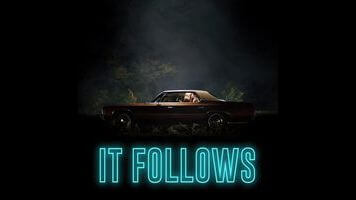It sounds like the stuff of slumber parties, a cautionary tale to be whispered by flashlight or embellished over a flickering flame: Sleep with the wrong person, as the teenage heroine of It Follows does, and the nameless thing will come for you. On the outskirts of Detroit, Jay (Maika Monroe) finds herself the target of this relentless, shape-shifting entity—a curse passed on through sex with Hugh (Jake Weary), her handsome but mysterious new squeeze. As he explains, only the afflicted can see the specter, which will sometimes take the form of someone she knows. It will follow her, persistently but always at a walk, until she either falls into its clutches or passes the burden to a new sexual partner. “Never go anywhere with only one exit,” Hugh warns.
There’s a primal, ingenious simplicity to that setup, one that writer-director David Robert Mitchell mines for one enormous scare after another. But It Follows is more than just an expertly calibrated scream machine. Set in the teenage wasteland of an indeterminate era, where bored young adults watch rabbit-ear TVs while pawing at custom mobile devices, the film twists the itchy melancholia of coming-of-age cinema into something more fatalistic. Mitchell, whose debut was the decidedly non-horror The Myth Of The American Sleepover, has returned to his native Michigan to hang with another group of suburban kids growing out of adolescence. The big difference is that it’s not just the future creeping up on them this time.
The suspense hits a fever pitch from the opening frames, when Mitchell punctures a sleepy neighborhood calm with a jagged burst of staccato violin. In a bravura single take, It Follows captures the evasive maneuvers of a petrified teen, bolting out her front door and away from the invisible terror on her tail. One grisly scene later, the focus shifts to Jay, first seen floating in a backyard swimming pool, like a distaff Benjamin Braddock. The edge-of-childhood aimlessness is hypnotic, but after the inciting incident—a most unpleasant walk of shame—Jay’s daydream summer becomes a nightmare. Together with a Scooby Gang of peers, including a smitten childhood friend (Keir Gilchrist) and her younger sister (Lili Sepe), Jay tries to hunt down the drifter who gave her the hex, all while dodging a very deadly shadow.
Having laid its ground rules, It Follows exploits them in inventive and extremely effective ways. As plenty of J-horror movies have already demonstrated, something walking right at the lens is scary; here, Mitchell works out several nerve-wracking variations on that scenario. One scene situates the camera in the hallway of a school, putting it on a 360-degree spin cycle, so that the apparition gets closer with each successive pass. Other times, the filmmaker employs deep focus photography, placing a speck-like figure in the far distance, generating tension from its glacial advance. Gradually, the background space of every shot becomes a source of menace, and every extra on screen becomes a potential threat. The film turns its viewers into paranoid spectators, scanning the frame for signs of trouble.
Fans of early John Carpenter will immediately identify the master’s influence—on the voyeuristic slink of the camera, the synth pulse of Rich Vreeland’s throwback score, and the transformation of “safe,” warmly lit residential environments into landscapes of dread. (The film even quotes Halloween’s classroom scene.) But It Follows is no knockoff. Undergoing an enormous creative growth spurt, Mitchell filters his influences through his own distinct brand of romantic naturalism. As in Myth, the young actors exhibit an almost complete lack of affectation, looking and talking like real kids, even as they refrain—in this out-of-time suburbia—from consulting social media. Mitchell’s dialogue, plainspoken but sharp, often nails the inarticulate poetry of youth. One intoxicating scene finds Monroe, even better here than she was in The Guest, sprawled out across the back seat of Hugh’s car, playing with some flowers as she waxes nostalgic. It’s lovely, until it most chillingly isn’t.
Throughout, Mitchell spikes his formally masterful horror with thick dollops of sexual anxiety. When the monster takes the form of a woman in a Halloween costume—scantily clad, with plastic vampire teeth and a stream of urine running down her leg—it’s as though the ghastly thing has emerged from a rancid wet dream. Elsewhere, the group finds a stack of dirty magazines squirreled away in an attic, like a private library of ancient sexual awakening. But as tempting it might be read the “it” of the title as a kind of walking STD, Mitchell hasn’t delivered the world’s spookiest health-class lecture. The metaphor is looser and more mythic: Jay and her friends are haunted by the slipping away of their carefree adolescence, day by uneventful day. When they cross 8 Mile, it’s like a pilgrimage into adulthood—that journey so many take from the shallow pool of their small-town lives into the raging waters of a big city. Such subtext is for the countless revisits this new horror milestone will inspire. On first viewing, just stay focused on not soiling yourself.


 Keep scrolling for more great stories.
Keep scrolling for more great stories.